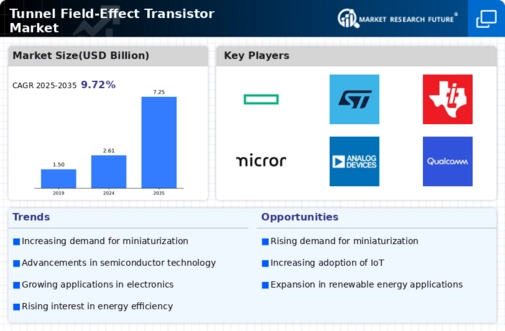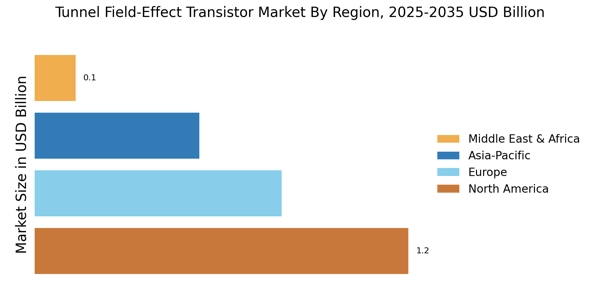Advancements in Semiconductor Technology
The Tunnel Field-Effect Transistor Market is significantly influenced by ongoing advancements in semiconductor technology. Innovations in fabrication techniques and materials science are enabling the development of more efficient and reliable TFETs. These advancements not only improve the performance of TFETs but also reduce production costs, making them more accessible to manufacturers. As semiconductor technology continues to evolve, the integration of TFETs into mainstream applications is likely to increase. The semiconductor market itself is expected to grow at a CAGR of around 10%, further bolstering the demand for TFETs as companies seek to leverage the latest technologies to enhance their product offerings.
Growing Focus on Miniaturization of Devices
The trend towards miniaturization in the electronics sector significantly influences the Tunnel Field-Effect Transistor Market. As devices become smaller, the need for components that can operate efficiently at reduced sizes intensifies. TFETs, with their compact design and ability to function effectively at lower voltages, are well-suited for integration into miniaturized devices. This trend is particularly evident in the smartphone and wearable technology markets, where space is at a premium. The miniaturization trend is expected to drive the TFET market, as manufacturers seek to incorporate these transistors into their next-generation products, potentially increasing market share by 20% in the coming years.
Increasing Demand for High-Speed Electronics
The Tunnel Field-Effect Transistor Market is experiencing a surge in demand for high-speed electronic devices. As technology advances, the need for faster processing speeds in consumer electronics, telecommunications, and computing systems becomes paramount. Tunnel field-effect transistors (TFETs) offer the potential for lower power consumption while achieving higher switching speeds compared to traditional transistors. This capability aligns with the industry's shift towards energy-efficient solutions, which is projected to grow at a compound annual growth rate (CAGR) of approximately 15% over the next five years. Consequently, manufacturers are increasingly investing in TFET technology to meet the evolving requirements of high-performance applications.
Rising Adoption of Internet of Things (IoT) Devices
The proliferation of Internet of Things (IoT) devices is a significant driver for the Tunnel Field-Effect Transistor Market. As more devices become interconnected, the demand for efficient, low-power transistors that can support continuous operation increases. TFETs are particularly advantageous in IoT applications due to their low power consumption and high efficiency, making them ideal for battery-operated devices. The IoT market is projected to expand rapidly, with estimates suggesting a growth rate of over 25% annually. This expansion creates a substantial opportunity for TFET technology, as manufacturers look to enhance the performance and longevity of their IoT products.
Environmental Regulations and Sustainability Initiatives
The growing emphasis on environmental regulations and sustainability initiatives is a crucial driver for the Tunnel Field-Effect Transistor Market. As governments and organizations worldwide implement stricter regulations on energy consumption and emissions, the demand for energy-efficient technologies rises. TFETs, known for their lower power requirements and reduced heat generation, align well with these sustainability goals. This alignment is likely to encourage manufacturers to adopt TFET technology in their products, thereby enhancing their market competitiveness. The sustainability trend is expected to influence the electronics industry significantly, with a projected increase in the adoption of energy-efficient components, including TFETs, by approximately 30% over the next few years.

















Leave a Comment